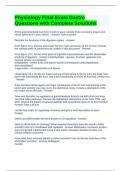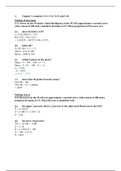Exam (elaborations)
Physiology Final Exam Gastro Questions with Complete Solutions
- Course
- Institution
Entire gastrointestinal tract from mouth to anus. Include three accessory organs and seven sphincters in your sketch. - Answer-Took a picture Describe the functions of the digestive system From figure 15.3, discuss and locate the four major processes of the GI tract. Include the relevant par...
[Show more]




